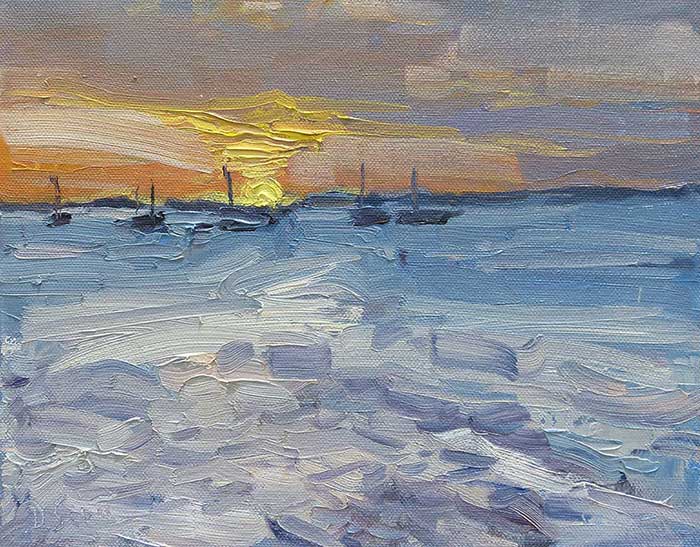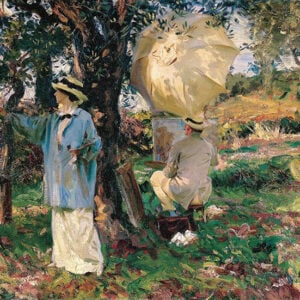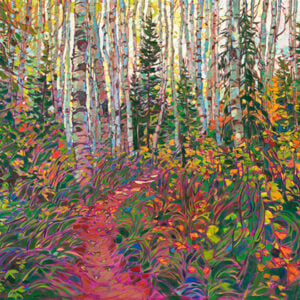It is no secret that I love the impressionist movement. But how exactly do you paint in an impressionist style?
Many artists seem to use it as an excuse to paint sloppily. But really, impressionism is just a relaxed form of realism in my opinion. Accuracy is still extremely important in impressionism.
In this post, we will run through some tips to help you paint like an impressionist.
- Characteristics of Impressionism
- 1. Use Broken Colors to Create the Illusion of Depth and Movement
- 2. Use Bold Strokes to Direct Your Viewer Around the Canvas
- 3. Use Large Brushes and Try to Capture Form With as Few Strokes as Possible
- 4. Use Your Palette Knife to Create Interesting and Sometimes Dramatic Effects
- 5. Contrast Warm and Cool Colors
- 6. If It Is Not Important, Simplify It
- Summary
- Want to Learn More?
- Thanks for Reading!
Characteristics of Impressionism
Before I get into the tips, here are some of the broad characteristics of impressionism:
- Broken color;
- Loose and fluent brushwork;
- Relaxed and sometimes inaccurate drawing;
- A focus on capturing the fleeting environment and how we see the world; and
- Compositions that place you in the painting.
1. Use Broken Colors to Create the Illusion of Depth and Movement
If you look up close at many of Claude Monet‘s paintings, you will notice that he rarely used a static color, but rather a myriad of broken colors that optically blend together when viewed from a distance. This gives Monet’s paintings a certain depth and vibrancy that few artists seem to be able to achieve.
Instead of painting the sky a static blue, Monet often used a range of broken yellows, purples, blues, and greens. Instead of painting trees a static green, Monet used broken reds, yellows, greens, and blues.
In most cases, Monet used a dominant color and many accent colors.

His paintings of water lilies are brilliant examples of broken colors. If you look up close, you can see just how many colors he used all through his paintings. Yet when you step back, everything works in a peaceful harmony.



2. Use Bold Strokes to Direct Your Viewer Around the Canvas
The top impressionists were not afraid to use bold and almost aggressive brushwork. If used appropriately, this kind of brushwork can add a very dynamic element to your paintings.
Vincent van Gogh is obviously the first artist to come to mind when we think of bold brushwork. In my opinion, his brushwork is one of the reasons for his great fame post-mortem.



3. Use Large Brushes and Try to Capture Form With as Few Strokes as Possible
Painting like an impressionist can best be achieved by using brushes much larger than what you are usually comfortable with. This will help you generalize shapes, colors and other elements in your paintings. But make no mistake, it is not easy to paint with large brushes and every stroke needs to be calculated and have a purpose.
The best way to learn how to paint with larger brushes is just to force yourself to use them. Put away your smaller brushes and try to complete a few paintings with just larger brushes.
In my small painting below, I used a very large brush for the entire painting. You can see the large brushstrokes in the sky.

4. Use Your Palette Knife to Create Interesting and Sometimes Dramatic Effects
The palette knife is an underrated painting tool in my opinion. You can create such interesting effects using the palette knife and it can help you paint like an impressionist as you can use it to apply thick areas of varied colors without going into too much detail.
High-quality palette knives crafted with stainless blades and ergonomically designed handles.
The palette knife is also perfect for adding small accents and highlights to your paintings (for example, the bright glimmer of sunlight that is hitting the top of the water in the distance of your seascape).
In my painting below, I used the palette knife to paint the dramatic yellows of the sun.

Magenta Flowers, Brisbane (below) was done almost entirely with palette knives. You can see this painting come together in this video.

5. Contrast Warm and Cool Colors
Many of the great impressionists contrasted warm and cool colors in their paintings to create stunning effects. This can be most effective when you have a dominant warm (cool) color contrast against a weaker cool (warm) color. For example, a dominant orange looks very brilliant when contrasted against a dirty blue color.

6. If It Is Not Important, Simplify It
To paint like an impressionist, you need to determine what is actually important in your painting and simplify the rest. If you start adding every detail in the scene you are painting from, then the overall message of your painting will get lost. You want to try and communicate your message through your painting with as few words (strokes) as possible.
With my painting, New Farm Park, Roses, notice how I simplified the sky and the trees in the back. They are really just simple color shapes. This helps focus attention on the roses in the foreground.

Summary
Most of these tips will help you simplify the clutter in your paintings and communicate what is actually important. After all, that is what impressionism is all about. Don’t confuse impressionism with reckless painting.
Want to Learn More?
You might also be interested in:
How I Painted This Impressionist Landscape: A practical demonstration of impressionist painting.
Painting Academy: I’ll walk you through the time-tested fundamentals of painting. It’s perfect for absolute beginner to intermediate painters.
Thanks for Reading!
I appreciate you taking the time to read this post and I hope you found it helpful. Feel free to share it with friends.
Happy painting!
Dan Scott

Draw Paint Academy








Great ideas, simply described and well illustrated. Thanks for these tips!
No problem Steph!
Dan
This article was super informative. Most of these acknowledge the obvious and tell u little to no new info for having read them. Your info was enlightening and even more, it is useful! I can’t wait to finish this message, I’m so anxious to pick up my paint brush, and try them all out. THANK YOU
I agree! I’m going to put my smaller brushes away for a try
To me impressionism represents the past & that’s the thing the “impressionist” we’re trying to break away from. Today painters try to paint “like impressionists” instead of painting in their own style. Stop painting for sales & paint for it’s own sake. I admire some of those rebels but l also like Manet & Renoir who weren’t “impressionists”.
Art created “from scratch”, ie without the intellectual capital that went before is not really art. I bet your artwork looks clumsy, infantile and naive…
The principles embedded in impressionistic painting are quite well thought-out and intellectual. A thorough study of what the impressionists were thinking, how they applied various theories and techniques in creating their work, and furthermore, the continuing fascination with and acceptance of their work to this day (albeit, at first rejected by the more classical, traditional painters and their following) speak volumes about the endurance of Impressionism.
There are, of course, as the author has said, those who equate Impressionistic painting with sloppy painting. But the difference can quickly be identified by anyone with an understanding of color theory and usage, composition and other elements, that used correctly, are brought together in harmony to create a great paintings. “Sloppy” paintings, created from true naivete, clearly express no idea of these things, great Impressionistic painters and their paintings clearly do, as the author of this article so ably describes through both his article and his paintings.
In my many courses in art history at the university level, one reason I believe Impressionism became popular and continues to be popular to this day is that Impressionistic painters have mastered simplifying what needs to be simplified to bring the viewer into participation of the painting, something that had not really been done before, wherein the viewer fills in any details through his own perception and imagination. This was a refreshing departure from the overly-detailed, all- spelled- out for the viewer, hard-edged paintings of before. A new age of painting had dawned – built upon the intellect and imagination of the Impressionistic painters, who were as far from being “naive” about painting as the east is from the west.
I hope,you be able to continue such a good describe about the subject that might take one years of study.I personally appreciate it very much from far distance & another side of the earth. with the best wishes
Thanks for the very kind words Hashem!
Dan
Great article — simply offered, well written, easy to read and full of wonderful creativity boosters. My one suggestion would be to call up some relevant examples for all (and not just some of) the tips you offer. The examples of other well known artists lends credibility, so avoid using your own examples. For instance, I’d have loved seeing some examples by a well known impressionist artist to illustrate your 3rd and 4th tips.
Hi Rob. Thanks for your very thoughtful feedback. I will try add some more examples to this post when I have time and certainly to future posts! Regards, Dan.
I have not mastered how to appreciate great paintings of the past masters. I find your (Dan Scott’s) paintings very attractive and the explanation is highly reasonable. You do not have to drop your examples. They are simple and charming.
I have entered my email address to subscribe but get the message that my email address is invalid. ????
Hi Julie
I will check to see what the issue is.
Thanks!
Dan
Thanks for the tips.
Anoma
No problem Anoma 🙂 Dan
I HAVE ALWAYS LIKED THE IMPRESSIONISTIC WAY OF PAINTING. I WANT TO PAINT MORE WITH A PAINT KNIFE TO BE ABLE TO PAINT THAT WAY.
Thanks William
Great tips,thanks.
Thanks Anne! Dan
Thanks for sharing with us. Claude Monet is one of my favorite artists, and here lately, I have this desire to paint more in the impressionist style, because of what I have read about Claude Monet. I even admire the kind of man he was in life, and I love the impressionist style he has paved the way for in art. I am working on a painting now that is still not all the way like Claude Monet’s, but I did use a palette knife in the background underpainting, so that helped leaning toward the impressionist style. I have Peruvian lilies, chrysanthemums, which was easy for the quick and short brushstrokes for the Impressionist style, and roses. I worked on the background last night, giving it less details, and that helped it lean toward the impressionism style. Thanks for sharing the Impressionist style with us.
Thanks Rosie! Dan
Really appreciate your article–I’m newly inspired!
Happy to hear Bev! Thanks, Dan
Very educational.
Thanks! Dan
I am greatly enjoying all your “tips” which are very well illustrated by the paintings you have chosen. I also like your own paintings and hope that you continue to post.
Thanks Frances! Definitely more to come. Dan
I ha e Ben painting for years with some success but want to loosen up and paint more freely. Your tips will help I am sure.
Thank You for sharing these brief but important tips! I have a book on impressionism (but never) seem to find the time to sit down & read. Your information is concise and right on! Examples always help me so I’m glad you included many (including) your own.
Thank you for all this information, it is clare, usefull and easy to understand. Great tips!
Thank you for the tips. I thought I had invented some of them as my own and now I see that somebody (you ) haven already implemented them. Makes me feel better with my amateur paintings.
Nilsa
i am trying to make myself paint again.
i guess just grab paints and brush and give it a go.
i find your work inspiring.
thanks, i will be following you.
mariella
Thanks a million Dan. Your ideas and tips have given a much required clarity. Impressionism is something like climbing a mountain with the perfectly and strategically placed least number of steps and as well said by you, it must not be an excuse for a sloppy painting.
I found your thoughts and tips VERY helpful. I hope to learn more from you in the near future!
Thank you so very much Dan
Hi Yash from India, 68, now 20 years drawing painting landscape, sea , sky and fields
Most are buddha faces as I visualise from memory, I gift them, an exhibition was a wash out But a look vangogh exhibition at Melbourne in 360• have settled my minds eye to do impressionist painting, as I see around mumbai
Can u guide to improve my work, will you comment about my paintings, I’d like to join your academy thanks
Hi,
Thank you for your easy reading short tutorial. I have painted now and then since I was 14 years old. Thats ages ago. I always regarded my paintings as impressionistic. Somebody told me that I paint naive which I didnt like to hear. But I think it was her lack of knowledge about impressionism. I am going to send your tips to her (with your permission).
.
Thank you Dan for helping me get inspired again. I am 81 and now have plenty of time to paint. I do water color. What medium are you using? Can a pallet knife work with water color? I want to learn how to paint looser. Really enjoying all of your tutorials!!
Hi Karen, I use oils. This post on loosening up might be a good read: https://drawpaintacademy.com/loosen-up/
Thanks! Dan
Dan . I started painting 8 weeks ago in my last painting it was mentioned that it had an impressionists style to it. I am self taught it kind of felt natural to paint this way . I read your article because I looked up what the style was about. I was going to add more details to my painting but the more I look at it especially from a distance looks better. I love the imperfections in my art that makes it unique and still deliver the emotion that I feel when I paint it. Thank you for the great article extremely helpful.
Gracias por los consejos, de alguien que sabe bastante de pintar,Dan* como los grandes maestros, del impresionismo y que nos los cuenta, de una manera sencilla, y facil de aplicar sobre un lienzo, pudiendo de esta manera animarnos a realizar nuestras propias obras pictoricas.
Very helpful, thank You.
Your tips, Dan, are very helpful. I live in Ontario Canada and like to paint as per the Group of 7 and Tom Thomson. Some of what you suggested I have learned from my instructor. I will certainly have your thoughts in mind while doing my next painting.